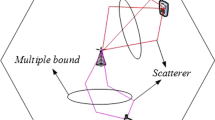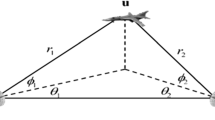Abstract
In presence of obstacles, localization is a real challenge since multi-path effect takes place due to reflections and/or scattering of signals. There are works in the literature which discard multiple-bound signals received by sensors using statistical methods and then localize sensors using remaining signals. In literature, to the best of our knowledge, there is no deterministic way to know the number of reflections/bounds of a particular signal, so researchers have to rely on statistical methods for localization. In this paper, we analyze multiple-bound signals based on the information gathered by different ranging techniques viz. AOA, TOA, RSSI and make use of a multiple-bound signal where number of reflections are not known, to localize sensor deterministically.










Similar content being viewed by others
References
Capkun, S., & Hubaux, J.-P. (2005). Secure positioning of wireless devices with application to sensor networks. In INFOCOM (pp. 1917–1928).
Delaët, S., Mandal, P. S., Rokicki, M. A., & Tixeuil, S. (2011). Deterministic secure positioning in wireless sensor networks. Theoretical Computer Science, 412(35), 4471–4481.
Ebrahimian, Z., & Scholtz, R. A. (2005). Source localization using reflection omission in the near-field. In IEEE-ACES conference on applied computational electromagnetics.
He, T., Huang, C., Blum, B. M., Stankovic, J. A., & Abdelzaher, T. (2003). Range-free localization schemes for large scale sensor networks. In Proceedings of 9th annual international conference on mobile computing and networking, MobiCom ’03, New York, USA, 2003. ACM (pp. 81–95).
Hsu, C.-C., Chen, H.-C., & Lai, C.-Y. (2009). An improved ultrasonic-based localization using reflection method. In CAR, IEEE Computer Society (pp. 437–440).
Liu, C. H., & Fang, D. J. (1988). Propagation. In Y. T. Lo & S. W. Lee. (Eds.), Antenna handbook: Theory, applications, and design (Vol. 29, pp. 1–56). New York, USA: Van Nostrand Reinhold.
Mondal, K., Mandal, P. S., & Sinha, B. P. (2012). Localization in presence of multipath effect in wireless sensor networks. In WWIC, vol. 7277 of lecture notes in computer science (pp. 138–149). Springer.
Pahlavan, K., Akgul, F. O., Heidari, M., Hatami, A., Elwell, J. M., & Tingley, R. D. (2006). Indoor geolocation in the absence of direct path. IEEE Wireless Communications, 13(6), 50–58.
Patil, M. M., Shaha, U., Desai, U. B., & Merchant, S. N. (2005). Localization in wireless sensor networks using three masters. In Proceedings of IEEE international conference on personal wireless communications (ICPWC’05) (pp. 384–388).
Röhrig, C., & Müller, M. (2009). Indoor location tracking in non-line-of-sight environments using a ieee 802.15.4a wireless network. In IROS (pp. 552–557).
Seow, C. K., & Tan, S. Y. (2008). Non-line-of-sight localization in multipath environments. IEEE Transactions on Mobile Computing, 7, 647–660.
Shih, C.-Y., & Marrón, P. J. (2010). COLA: Complexity-reduced trilateration approach for 3D localization in wireless sensor networks. In SENSORCOMM ’10, Washington, USA (pp 24–32).
Sun, Q., Tan, S. Y., & Teh, K. C. (2005). Analytical formulae for path loss prediction in urban street grid microcellular environments. IEEE Transactions on Vehicular Technology, 54(4), 1251–1258.
Uchiyama, A., Fujii, S., Maeda, K., Umedu, T., Yamaguchi, H., & Higashino, T. (2007). Ad-hoc localization in urban district. In INFOCOM, IEEE (pp. 2306–2310).
Wann, C.-D., & Hsueh, C.-S. (2011). Non-line of sight error mitigation in ultra-wideband ranging systems using biased kalman filtering. Signal Processing Systems, 64(3), 389–400.
Zhang, Y., Liu, W., & Fang, Y. (2006). Secure localization and authentication in ultra-wideband sensor networks. IEEE Journal on Selected Areas in Communications, 24(4), 829–835.
Acknowledgments
The first author is thankful to the Council of Scientific and Industrial Research (CSIR), Govt. of India, for financial support during this work.
Author information
Authors and Affiliations
Corresponding author
Rights and permissions
About this article
Cite this article
Mondal, K., Mandal, P.S. & Sinha, B.P. Analysis of Multiple-Bound Signals Towards Localization: A Theoretical Approach. Wireless Pers Commun 83, 49–67 (2015). https://doi.org/10.1007/s11277-015-2379-1
Published:
Issue Date:
DOI: https://doi.org/10.1007/s11277-015-2379-1




